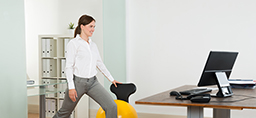
For many employers across the country, the work-from-home setup is looking increasingly like it’s here to stay.
And often, it’s a benefit to employees. They spend less time commuting and they can tend to personal matters amidst the demands of work, among other perks.
But it can also be difficult to balance the demands of these two worlds when the office is omnipresent.
Sometimes, this means health and wellness isn’t prioritized as it should be.
With a little planning, however, you can keep your health goals top of mind—and you might even find you can improve your productivity when you’re working from home.
“Any type of healthy lifestyle is maintainable and successful if there is a schedule,” said Dan Clapper, a certified athletic trainer and Spectrum Health Sports Medicine supervisor. “Plan your workday ahead of time. Plan your breaks and what you’re going to do during the breaks.”
The right stuff
Clapper, who also oversees the Spectrum Health Orthopedics at Work program, is well-versed in the creation of work environments that promote good health.
The first task: Get the home office properly equipped and the work area organized.
One of the most important pieces is a good chair, Clapper said. It should be comfortable, with good lumbar support. It can be something as simple as a pillow or an adjustment built into the chair.
The chair should also have a cushion. Set the height of the chair to keep the hips, knees and ankles at 90-degree angles. If it’s too high or too low it can put undue pressure on these lower body parts as well as the lumbar spine and thighs.
Good posture is paramount.
Make sure your shoulders aren’t elevated. They should be in a relaxed position.
Forearms and elbows should not be in constant contact with the chair or the surface of the desk or table.
A laptop is often fine, but don’t rely on that alone. Have a monitor, keyboard, mouse and a docking station—something that connects all the devices.
The monitor’s height should be about eye-level, with your focus on the middle of the screen. Avoid looking down at the screen.
Anything you use consistently should be close at hand, Clapper said. Your smartphone, for example, should be within an arm’s length, because reaching too far can create chronic pain in the shoulders and upper back.
Take a break
If you have a workstation that allows you to sit or stand, you generally shouldn’t stand for more than 20 to 30 minutes every two hours. You can stand more often than you sit—but don’t sit longer than about an hour to an hour and a half.
Between sitting and standing, take a break. Aim for a short break every hour or two, or whenever the schedule allows.
“Breaks can be as simple as stretching or walking, or even using your workout equipment,” Dr. Clapper said. “What you do during a break is up to you—whatever you are comfortable with, whatever you have time for and whatever is available.”
The timing of breaks is important. That’s why it’s good to maintain a set schedule to incorporate them.
You can take breaks between tasks or between phone calls.
Also, make sure the monitor isn’t facing the window, Clapper said—the contrast from the light isn’t good for the eyes and the external lighting could create too much glare.
While it’s not good to have a lamp or overhead light that affects the monitor, some type of lighting is appropriate. Don’t sit in the dark.
The goal is to create an office that is ergonomically correct, Clapper said.
The changes he recommends are meant to reduce chronic injury and pain, especially to the lower back or spine, neck and shoulders. It can also reduce the risk of carpel tunnel syndrome.
Food and fitness
In some respects, it may be easier to maintain a healthy lifestyle when working from home.
If you have exercise equipment in the house, for example, you can incorporate these into your workday.
“There are a lot of little benefits to working at home,” Clapper said. “Saving time by not having to commute to the office is one, as long as you can maintain your work productivity.”
Access to healthy food is another benefit, but you have to plan ahead to eat healthy. At home, you know where everything is—healthy food, but also unhealthy snacks.
A smart approach: Choose wisely when you’re grocery shopping.
Nutrition and hydration are also critical to a heathy lifestyle when you’re working at home. You have to remind yourself to stay hydrated with plenty of water, Clapper said.
“You can be successful at work and have a healthy lifestyle if you’re able to schedule appropriately and take advantage of opportunities to stay active,” Clapper said. “And with proper home office ergonomics, you can reduce the risk of injury.”
 /a>
/a>
 /a>
/a>
 /a>
/a>